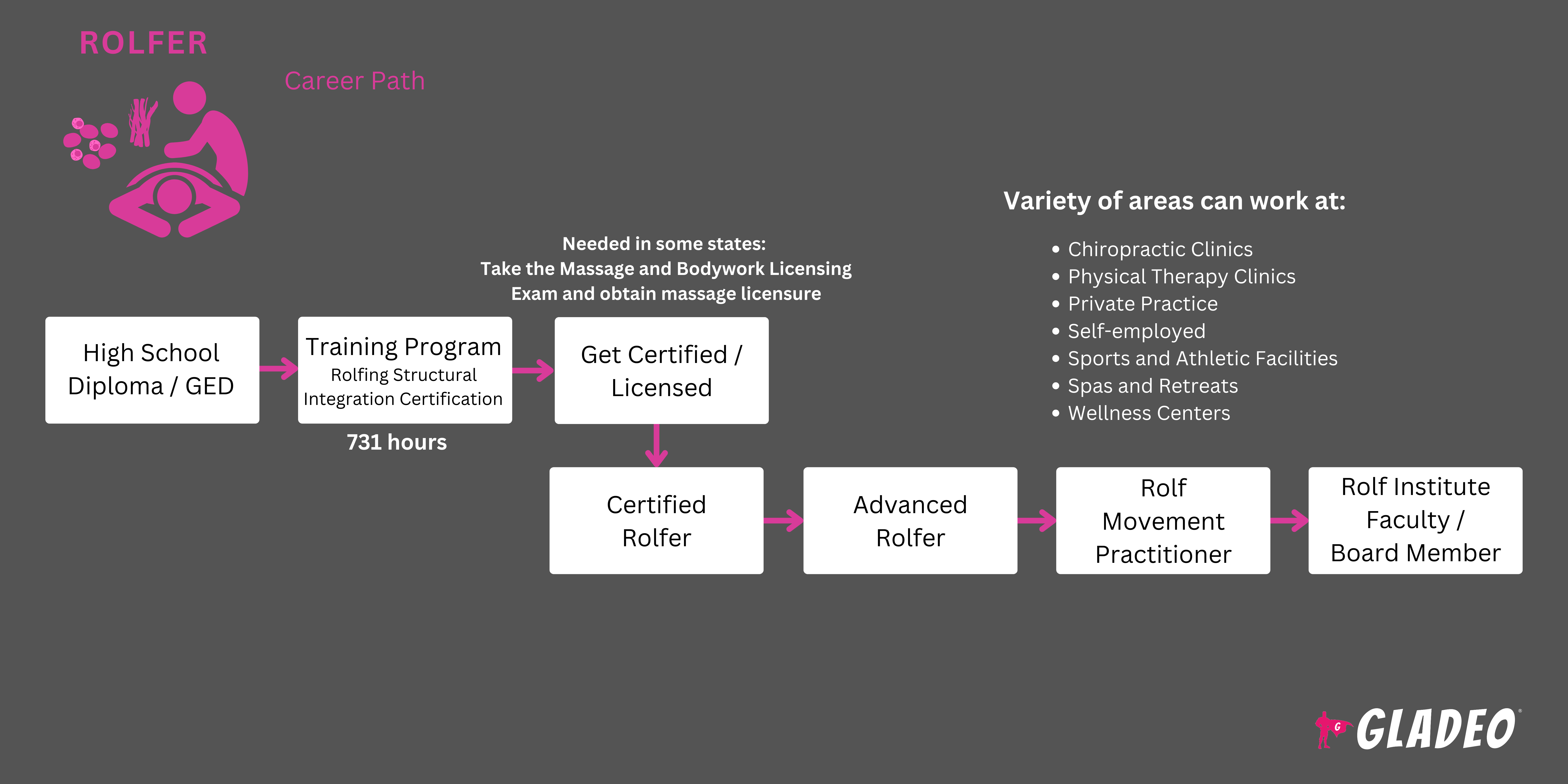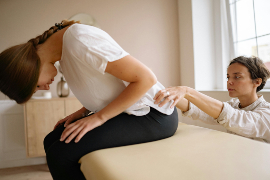Focos
Masajista terapéutico, fisioterapeuta, quiropráctico, terapeuta de liberación miofascial, terapeuta craneosacral.
¿Alguna vez te has preguntado qué mantiene nuestros músculos, huesos, nervios y órganos en su sitio? Bajo nuestra piel y recorriendo todo nuestro cuerpo hay capas de tejido conectivo en forma de red llamadas fascia. Esta red de fascia proporciona el soporte estructural que permite que las diferentes partes de nuestro cuerpo funcionen como un todo integrado.
Debido a que la fascia está interconectada, cualquier lesión o restricción en una zona puede afectar a otras zonas de nuestro cuerpo. Esto puede provocar síntomas como dolor, rigidez, tensión y mala postura. Hay varias formas de tratar estos síntomas, desde estiramientos y masajes hasta fisioterapia, analgésicos e incluso cirugía. Una de las opciones menos conocidas es acudir a un terapeuta Rolfing.
Los rolferos practican una forma de trabajo corporal profundo llamado «integración estructural Rolfing», que manipula la fascia para corregir desalineaciones físicas, restaurar la elasticidad y liberar al cuerpo de molestias. A simple vista, los tratamientos parecen similares a la terapia de masajes, pero el Rolfing tiene un enfoque más amplio que va más allá de la relajación muscular y el alivio del estrés.
El Rolfing, que lleva el nombre de la bioquímica Dra. Ida Rolf, ha ganado popularidad desde su fundación en 1971. Desde entonces, se han desarrollado varios sistemas derivados, pero el único lugar en los Estados Unidos donde se puede formarse y obtener la certificación en el método holístico original del Rolfing es el Instituto Dr. Ida Rolf (DIRI) en Colorado.
- Reducir el dolor de los clientes y ayudarles a conseguir una mejor postura y movilidad.
- Mejorar la calidad de vida general de los clientes, especialmente de aquellos que padecen molestias crónicas.
- Colaborar con los clientes en el bienestar a largo plazo y la conciencia corporal.
- Salario potencialmente lucrativo, con ingresos medios de entre 130 y 160 dólares por hora.
«Marcar la diferencia en la vida de las personas ayudándolas a sentirse mejor con su cuerpo. Para algunas personas, esto supone un alivio del dolor crónico. Para otras, mejora la confianza en su postura y su imagen corporal. ¡Ayudar a una población diversa a aceptarse tal y como son y a utilizar su cuerpo es extremadamente gratificante!». - Matthew Hartman, terapeuta rolfista en Structural Integration Bodywork.
Horario de trabajo
- Los rolferos suelen trabajar a tiempo completo, lo que puede incluir entre 4 y 6 horas al día dedicadas a proporcionar terapia manual directa a los clientes. Muchos rolferos son autónomos o trabajan en centros de salud holísticos, spas o consultas privadas. Los que tienen su propio negocio también dedican tiempo a gestionar las actividades relacionadas con el mismo.
Funciones típicas
- Programar una sesión inicial con un cliente. Analizar sus síntomas y evaluar la alineación física de su cuerpo.
- Identificar y tratar las zonas con dolor crónico, movilidad limitada o lesiones.
- Personaliza un plan para ayudar a aliviar los síntomas del cliente y corregir su postura.
- Explique al cliente lo que puede esperar durante las sesiones.
- Tenga en cuenta que los terapeutas Rolfers suelen recomendar a sus clientes que completen un tratamiento de 10 sesiones, con sesiones de mantenimiento rutinarias, según sea necesario.
- Discuta las posibles contraindicaciones, si las hay. Por ejemplo, un terapeuta de Rolfing puede necesitar tener especial cuidado con cualquier zona del cuerpo que haya sido operada quirúrgicamente.
- Realizar terapia manual para manipular la fascia del cuerpo. Supervisar las reacciones del cliente a la terapia mientras se realiza. Fomentar la comunicación abierta y la retroalimentación.
- Evalúa la postura y la movilidad del cliente después de cada sesión.
Ofrece recomendaciones para el cuidado posterior a la sesión, como hidratación, descanso o actividades específicas que se deben evitar. - Instruir al cliente sobre la mecánica corporal, los patrones de movimiento y las formas de mantener las mejoras entre sesiones, como ejercicios y estiramientos.
- Reserve sesiones de seguimiento, programadas según el plan de tratamiento del cliente.
- Toma notas, escucha los comentarios de los clientes y supervisa el progreso.
- Realice los ajustes necesarios en los planes de tratamiento.
Responsabilidades adicionales
- Mantenga un entorno de tratamiento higiénico y relajante. Mantenga las camillas de masaje limpias y en buen estado.
- Ayudar a los clientes a sentirse cómodos durante las sesiones. Proporcionar apoyo motivacional a los clientes que trabajan a pesar de las molestias físicas.
- Siga las directrices locales y nacionales para las prácticas de trabajo corporal.
- Manténgase al día de las últimas novedades. Realice cursos de formación continua sobre anatomía, biomecánica y técnicas de Rolfing, si le resultan útiles para ampliar sus conocimientos en el ámbito profesional.
- Para quienes tienen su propio negocio:
- Obtenga una licencia comercial y alquile un espacio de trabajo adecuado.
- Crea un espacio de trabajo relajante y privado, libre de distracciones y ruidos externos.
- Promociona y publicita el negocio. Establece la presencia online del negocio a través de un sitio web, un perfil de Google Business, redes sociales y otras plataformas adecuadas.
- Cumpla con las normas de publicidad sobre salud. Evite hacer afirmaciones médicas relacionadas con los servicios ofrecidos. Considere describir los servicios en términos de beneficios, como una mejor postura, un mayor rango de movimiento y una mayor conciencia corporal.
- Colabora con quiroprácticos, fisioterapeutas y profesionales del bienestar para obtener referencias y crear una base de clientes.
- Desarrollar una forma eficiente para que los clientes reserven citas y realicen pagos.
- Desarrollar y mantener buenas relaciones con los clientes para fomentar la repetición de negocios.
Implementar métodos de retención de clientes, como correos electrónicos de seguimiento, actualizaciones personalizadas sobre los tratamientos, programas de fidelización o revisiones posteriores al tratamiento. - Pida suministros, como aceites para masajes, toallas, desinfectante, velas de aromaterapia u otros artículos para el espacio de trabajo.
- Contrate un seguro de responsabilidad civil, responsabilidad profesional y cobertura de bienes.
- Lleve un registro de los ingresos y gastos. Presente las declaraciones de impuestos estatales y federales.
Habilidades sociales
- Analítico
- Atención al detalle
- Comunicación
- Coordinación
- Toma de decisiones
- Empatía
- Habilidades interpersonales
- Habilidades motivacionales
- Resolución de problemas
- Gestión del tiempo
Habilidades técnicas
- Sólidos conocimientos de anatomía, fisiología y biomecánica.
- Conocimiento de las técnicas de Rolfing y los principios de la manipulación fascial.
- Capacidad para evaluar y corregir los desequilibrios posturales.
- Competencia en la observación de patrones de movimiento y alineación física.
- Familiaridad con prácticas de salud holísticas y terapias complementarias.
- Comprensión del tratamiento del dolor crónico.
- Habilidades para el mantenimiento de registros y la documentación.
- Destreza, fuerza y resistencia.
- Autónomo
- Spas y centros de bienestar
- Práctica privada
- Instalaciones de rehabilitación
- Clínicas de medicina deportiva
Los rolferos suelen trabajar con clientes que sufren dolor crónico o problemas de movilidad, por lo que el trabajo requiere una buena dosis de empatía y paciencia. Además, el rolfing es un trabajo físicamente exigente, por lo que los rolferos deben desarrollar y mantener su fuerza y resistencia para realizar bien su trabajo.
Los autónomos deben gestionar tareas relacionadas con el negocio, como mantener un espacio de trabajo adecuado, publicitarse, programar citas, cobrar, llevar registros financieros y pagar impuestos. Al principio puede resultar difícil encontrar suficientes clientes, por lo que los rolferos deben perseverar y comercializar sus servicios de manera eficaz.
Las tendencias recientes en Rolfing destacan su creciente papel en la terapia complementaria, especialmente para el dolor crónico y los problemas de movilidad. Por ejemplo, las investigaciones indican que el Rolfing puede contribuir a mejorar el tratamiento del dolor lumbar crónico y la función motora en casos de parálisis cerebral espástica.
Además, el Rolfing se muestra prometedor para el tratamiento de la fibromialgia, ya que los estudios señalan una reducción del dolor, la ansiedad y la depresión meses después del tratamiento. Esto pone de relieve el potencial del Rolfing como mecanismo de apoyo a largo plazo para el tratamiento de los síntomas.
«En los últimos 15 años se han realizado numerosas investigaciones sobre la fascia, ¡muchísima información nueva desde que me formé en Rolfing hace 21 años!
Me gusta estar al día con esta investigación para estar bien informado y poder informar adecuadamente a mis clientes. La fascia es el tejido principal (junto con los músculos, tendones, ligamentos y vísceras) con el que trabajamos en el Rolfing.
La Dra. Ida P. Rolf (fundadora del Rolfing) creía en la década de 1940 que la fascia era «la fuerza imprevista en la salud humana». Desde entonces, ahora disponemos de mucha más información respaldada por investigaciones sobre el papel de la fascia en el movimiento, la comunicación neurológica y los fenómenos psicoemocionales». - Matthew Hartman, terapeuta de Rolfing en Structural Integration Bodywork.
Es posible que los rolferos hayan disfrutado de actividades como el yoga, la danza o los deportes que enfatizan la conciencia corporal. Probablemente hayan tenido un interés temprano por el masaje o la fisioterapia, además de una pasión por ayudar a los demás.
«Mis días son bastante sencillos, la verdad. Normalmente trabajo de 9 a 5, cinco días a la semana. Veo a un cliente cada hora durante aproximadamente una hora. Antes de cada jornada, dedico 30 minutos a revisar las notas de cada cliente de sus citas anteriores para estar preparada para cada sesión.
La higiene es muy importante en mi trabajo, por lo que debo lavarme las manos entre cada sesión y tener sábanas, fundas de almohada y mantas limpias preparadas para cada sesión». - Matthew Hartman, terapeuta de Rolfing en Structural Integration Bodywork.
- En Estados Unidos, los estudiantes pueden recibir formación a través del programa de certificación Rolfing® Structural Integration (RSI) del Dr. Ida Rolf Institute (DIRI) en Boulder, Colorado.
- También hay escuelas internacionales autorizadas de Rolfing en Canadá, Brasil, Alemania y Japón.
- El programa RSI de DIRI tiene una duración de 28 semanas, que incluyen tres fases más descansos entre cada fase. En total, la formación RSI abarca 731 horas de estudio, con cursos de anatomía, fisiología y kinesiología, junto con técnicas prácticas de Rolfing y prácticas supervisadas.
- Algunos estados exigen que los rolferos tengan la misma licencia que los masajistas terapéuticos. En tales casos, es posible que los rolferos deban aprobar el examen de licencia de masaje y trabajo corporal (MBLEx)https://fsmtb.org/mblex/. Los requisitos para el MBLEx pueden incluir:
- Tener al menos 18 años de edad.
- Aprobar el examen
- Completar un número mínimo de horas de formación en terapia de masajes en un programa aprobado o acreditado (como la formación RSI impartida en DIRI).
- Los estudiantes también pueden optar por asistir al programa de certificación Rolf Movement® Integration (RMI) de DIRI y al programa de certificación avanzada Rolfing®.
- También se ofrecen cursos de formación continua para ayudar en el desarrollo profesional.
- Los terapeutas Rolfing no necesitan un título universitario. En Estados Unidos, el Instituto Dr. Ida Rolf (DIRI) de Boulder, Colorado, es el único centro de formación homologado que ofrece el programa de certificación Rolfing® Structural Integration (RSI).
- Tenga en cuenta que la Asociación Internacional de Integradores Estructurales ofrece programas alternativos similares y, en algunos casos, derivados de las prácticas de Rolfing. ¡Simplemente no pueden utilizar la marca registrada «Rolf»!
- DIRI ofrece una vía para que los profesionales de la integración estructural que no pertenecen a DIRI puedan convertirse en miembros de DIRI.
- Los estudiantes de Rolfing pueden desear estudiar kinesiología, ciencias del ejercicio, masaje o temas relacionados antes de asistir al DIRI. Hay muchos colegios comunitarios y escuelas de masaje donde se pueden tomar estas clases. Algunos cursos se pueden tomar en línea, pero muchos requieren experiencia práctica presencial.
- Compare los costos de matrícula y cuotas, teniendo en cuenta los costos dentro del estado frente a los costos fuera del estado. Tenga en cuenta que DIRI es una escuela sin titulación universitaria (NCD).
- Revisa las opciones de becas y ayuda financiera. Si solicitas ayuda federal Pell Grants, asegúrate de que el dinero se pueda utilizar para pagar la matrícula de la escuela que te interesa.
- El Instituto Dr. Ida Rolf (DIRI) en Boulder, Colorado, ofrece un programa de certificación en Integración Estructural Rolfing® (RSI) de 28 semanas de duración.
- Inspirada en el Rolfing está la práctica de la Integración Estructural, que puede estudiarse a través de programas aprobados por la Asociación Internacional de Integradores Estructurales (IASI).
- La IASI representa a un amplio campo de profesionales de la integración estructural, incluidos aquellos formados en Rolfing y modalidades relacionadas, tales como:
- Integración estructural de Anatomy Trains
- Integración estructural Hellerwork
- Integración miofascial Kinesis
- Integración neuromuscular SOMA
- Integración estructural central
- Los estudiantes que se gradúen de un programa IASI pueden rendir el examen de certificación en integración estructural.
- Toma clases de biología, anatomía y educación física en la escuela secundaria para adquirir conocimientos básicos sobre la mecánica corporal.
- Practicar deportes, hacer ejercicio con regularidad o practicar yoga o pilates puede ser beneficioso, ya que permiten conocer de primera mano los principios de la kinesiología relacionados con el movimiento humano.
- Trabaja como voluntario o a tiempo parcial en centros de bienestar, spas o negocios de masoterapia.
- Explora las técnicas de trabajo corporal a través de talleres o cursos en línea en áreas como la terapia de masajes o la educación del movimiento.
- Establece contactos con otros profesionales del trabajo corporal. Únete a asociaciones de salud holística o clubes estudiantiles relacionados con la salud y el bienestar.
- Mira vídeos de YouTube sobre Rolfing, masajes, kinesioterapia y fisioterapia.
- Lee estudios y artículos sobre Rolfing y participa en foros de debate como Reddit.com/r/Rolfing/.
- Suscríbase a la revista Structure, Function, Integration(Estructura, función, integración) de DIRI.
«¡Desarrolla buenas habilidades comunicativas y sociales! Gran parte de mi trabajo consiste en tratar con personas de forma individual. Para ello, debo tener en cuenta muchos aspectos diferentes de cada persona: físicos, psicológicos, circunstancias vitales, dinámica familiar, historial médico, traumas pasados, etc.
Las habilidades de comunicación eficaz y relación humana me ayudan a crear un espacio para todas las partes de cada cliente. Además, las ciencias generales y la anatomía y fisiología son materias útiles. Asistir a una clase de masaje para aficionados en un centro de formación profesional local es una buena idea para introducir el concepto del tacto». - Matthew Hartman, terapeuta Rolfing en Structural Integration Bodywork.

- Muchos terapeutas Rolfing montan su propio negocio, pero incluso ellos pueden querer adquirir primero algo de experiencia laboral con un empleador.
- Completa tu certificación en Rolfing y cualquier requisito específico del estado, como una licencia de masajista.
- Revisa los anuncios de empleo en sitios web como Indeed, Monster y Glassdoor.
- Destaca en tu currículum palabras clave y habilidades como:
- Corrección de la alineación corporal
- Evaluación postural del cliente
- Salud del tejido conectivo
- Manipulación fascial
- Optimización del movimiento funcional
- Terapia manual
- Técnicas para el manejo del dolor
- Movilización de tejidos blandos
- Integración estructural
- Revisa las plantillas de currículum para masajistas y las preguntas más habituales en las entrevistas. Practica simulacros de entrevistas con un amigo.
- Pide a las personas de tu red profesional que te den consejos sobre ofertas de trabajo.
- Solicita cartas de recomendación a tus antiguos supervisores o profesores. ¡Pídeles permiso antes de facilitar su información de contacto!
- Vístete de manera profesional para las entrevistas de trabajo.
- Si trabajas para un empleador, hazle saber a tu supervisor que estás interesado en avanzar en tu carrera profesional.
- Desarrollar relaciones sólidas con los clientes, proporcionar un servicio excelente y prestar mucha atención a los comentarios.
- Manténgase al día con los cursos de formación continua de Rolfing.
- Promociona tus servicios profesionales en las redes sociales y considera la posibilidad de crear un canal de YouTube.
- Manténgase al día con las últimas investigaciones sobre biomecánica, terapia del movimiento y prácticas somáticas.
- Ofrece talleres, clases o seminarios sobre alineación corporal y corrección postural.
- Participa activamente en organizaciones profesionales como la Fascia Research Society.
- Considera la posibilidad de mudarte si es necesario para avanzar en tu carrera profesional. Algunas ciudades y pueblos ofrecen más oportunidades que otros.
- Según NiceRx, los estados que más utilizan medicinas y terapias alternativas son Hawái, California, Washington, Oregón y Colorado.
- Ponga en marcha su propio negocio y considere la posibilidad de contratar o asociarse con otros profesionales del sector del bienestar.
Sitios web
- Asociación de Profesionales del Masaje y el Trabajo Corporal
- Instituto Dr. Ida Rolf (antes Instituto Rolf de Integración Estructural)
- Guía de investigación sobre la fascia
- Sociedad de Investigación sobre la Fascia
- Asociación Internacional de Integradores Estructurales
- Revista de Terapia de Masajes
- Fundación Rolf para la Investigación
- Estructura, función, integración
- Asociación Internacional de Terapia Educativa del Movimiento Somático
Libros
- Anatomía de los trenes: meridianos miofasciales. Estructura y función. Guía de estudio, por Thomas Myers.
- Rolfing y la realidad física, por Ida P. Rolf
- La red infinita: anatomía fascial y realidad física, por Louis Schultz
Los rolferos son miembros importantes, pero a menudo poco reconocidos, de la comunidad dedicada a la salud y el bienestar. Dado que muchas personas no están familiarizadas con el rolfing, puede resultar difícil encontrar suficientes clientes en determinadas zonas geográficas, especialmente en las primeras etapas de la carrera profesional.
Si te interesa explorar otras opciones, ¡echa un vistazo a nuestra lista a continuación para conocer algunas profesiones alternativas!
- Entrenador deportivo
- Quiropráctico
- Fisiólogo del ejercicio
- Entrenador físico
- Entrenador de salud
- Masajista
- Gerente de Servicios Médicos y de Salud
- Terapeuta ocupacional
- Entrenador personal
- Fisioterapeuta
- Asistente de fisioterapia
- Instructor de Pilates
- Especialista en rehabilitación
- Médico especialista en medicina deportiva
- Instructor de yoga
«Si te interesa el Rolfing, te recomiendo encarecidamente que recibas la Serie 10 de Rolfing de un terapeuta certificado. La Serie 10 es la base de las teorías y principios de Ida Rolf y puede ser un proceso muy transformador.
Póngase en contacto con un terapeuta Rolfista de su zona a través del Instituto Dr. Ida Rolf (www.rolf.org). Si decide formarse para ser terapeuta Rolfing, le recomiendo que busque un terapeuta Rolfing con experiencia que pueda guiarle durante unos años después de la formación». - Matthew Hartman, terapeuta Rolfing en Structural Integration Bodywork.
Fuente de noticias

Empleos destacados

Cursos y herramientas en línea

Expectativas salariales anuales
Los nuevos trabajadores comienzan con un salario de alrededor de 34 000 dólares. El salario medio es de 51 000 dólares al año. Los trabajadores con mucha experiencia pueden ganar alrededor de 100 000 dólares.
Expectativas salariales anuales
Los nuevos trabajadores comienzan con un salario de alrededor de 38 000 dólares. El salario medio es de 50 000 dólares al año. Los trabajadores con mucha experiencia pueden ganar alrededor de 76 000 dólares.
Expectativas salariales anuales
Los nuevos trabajadores comienzan con un salario de alrededor de 34 000 dólares. El salario medio es de 57 000 dólares al año. Los trabajadores con mucha experiencia pueden ganar alrededor de 107 000 dólares.






